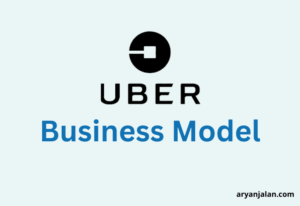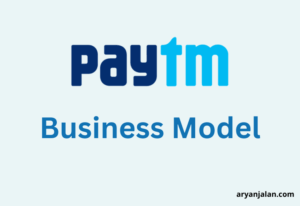In today’s competitive landscape, striking the perfect balance between effective resource management and delivering superior results to clients is crucial. This is where resource management tools become essential.
With this in mind, we’ve conducted thorough research to bring you a list of the best resource management tools available. These tools are designed to help your business track, plan, and allocate resources efficiently, ensuring peak performance.
Don’t miss out on optimizing your project management. Explore the features, pros and cons, and pricing of these tools to find the perfect match for your projects and budget.
1. Hive

Hive is a well-known resource and project management platform. It helps you to improve your workplace productivity. The tool’s simplest design makes it easy to manage multiple projects, tasks, deadlines, requests, approvals, notes, and reminders all in one place.
With 100s of templates and customizable project views. Hive also offers time-tracking and resource-planning functionality. With over six layouts, users can adapt to their unique workflows.
Hive Features:
- A built-in chat feature that enables real-time communication with teams.
- Utilize time sheets and time tracking to manage the team’s time effectively.
- Connect a dozen apps to Streamline work from anywhere.
- Wide range of customizable options and flexible project views.
- Direct tracking of approvals and feedback on client documents
Pros:
- The interface is user-friendly, making it easy to view and schedule resources.
- It can be easily adjusted to any workflow or process.
- Responsive customer support.
- Saves time by automating repetitive tasks.
Cons:
- Some external apps can be challenging to integrate.
- The app functionality is not good as compared to the desktop version.
- The platform has certain glitches from time to time, which makes it hard for users to navigate.
Hive Pricing:
- Try Hive free for 14 days
- Starter: Starting at $5
- Pro: Starting at $12
2. Float

Float is another powerful resource management tool in the list. It allows you to manage your team so well that most of your time goes to the actual work.
With Float user-friendly interface, you can easily manage the team and multiple projects in realtime. Either if it is related to time management, working hours, skills tracking or task scheduling, budgeting, project phases and timelines.
Features:
- Shows the entire team’s schedule and their current workload and leave days.
- import and assign public holidays
- Timesheets are used to track planned and actual work time.
- Easily schedule resources by drag-and-drop tools.
- Custom tags, such as location and skills, can be assigned to individuals and projects.
- Assists in connecting with your existing tools and workflows.
- Float’s reports provide valuable insights and help make data-driven improvements.
- Set a scheduled status, ensures everyone knows when you’re working from home or remotely,
Pros:
- Easy user interface
- Project status is presented visually effectively.
- Better resource management
- Predicting capacity and budget expenditures
- Flexible customization options
- Fast generating reports
Cons:
- Navigation difficulty
- Managing numerous colleagues and clients can be challenging to differentiate between hours logged per client and user
- The feature to add subtasks is missing
- Not a desktop-friendly app
Pricing:
- Starter: Starting at $6
- Pro: Starting at $10
3. Resource Guru
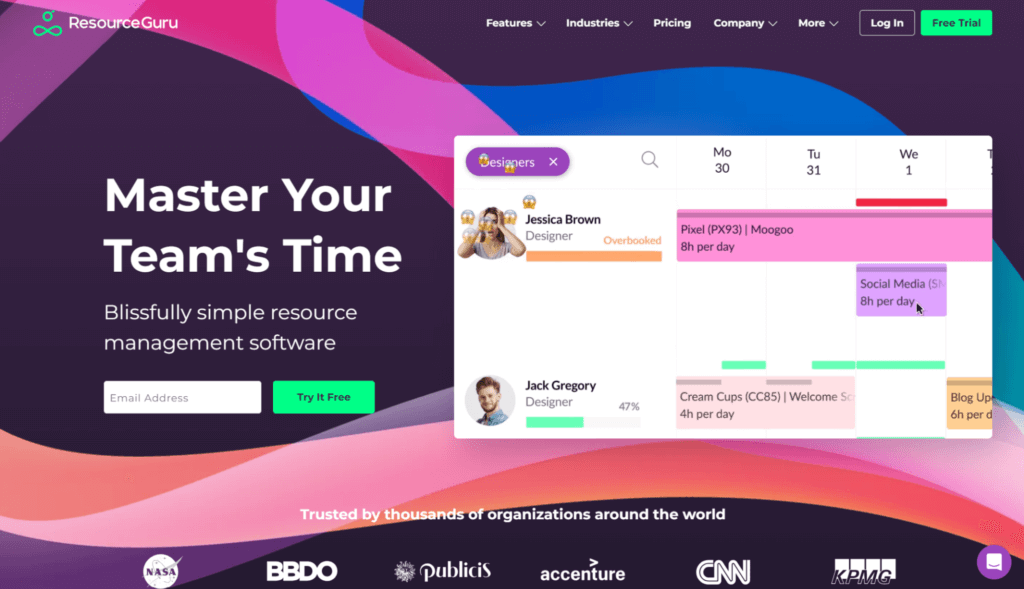
Resource Guru is one of the oldest and most effective resource management software that simplifies task scheduling, assigning work, and project tracking. It also offers a user-friendly platform for managing people, equipment, and meeting rooms in one place.
The tool offers daily schedule emails and personalized dashboards, tracking workload and deadlines. It also offers leave management features, allowing for tracking vacations, sick days, and parental leave.
Project managers can add bookings to a waiting list if a person is overbooked. The tool also features a smart calendar for task scheduling and advanced analytics for accurate forecasting and decision-making.
Features:
- Personal dashboards to track individual work and view tasks assigned to them.
- Meeting room booking system
- Project forecasting reports
- Integrates with 1500+ other apps
- Monitors team utilization and planning for future capacity.
- Utilize the leave management features to manage vacations, sick days, parental leave, and other absences.
Pros:
- Flexible User interface
- Quick and easy to set up
- Booking systems for room and equipment
- Quick allocation of resources
- Ability to do detailed planning and see capacity and availability across multiple teams.
Cons:
- Limited color options available for reports and data inputs
- Doesn’t have a real iOS/Android app
Pricing:
- Free 30-day trial available
- Grasshopper: $4.16 for one person per month
- Blackbelt: $6.65 for one person per month
- Master: $10 one person per month
4. ClickUp

ClickUp is a custom-built resource management software that offers an all-in-one productivity platform. With ClickUp, teams can strategize, organize, and collaborate on projects using various tools like tasks, docs, chat, goals, and whiteboards.
Its user-friendly UI allows users to customize workflows and visualize their work in various ways. ClickUp’s workload and timeline views ensure that tasks stay on track and deadlines are accurately met.
It integrates easily with existing tools and provides real-time metrics on billings, time allocation, and pending tasks.
Features:
- Dashboards with customizable widgets
- 15+ custom views including list, board, Gantt, and more.
- Native time tracking
- Plan and organize projects, ideas, and tasks, enabling the connection between them and mapping workflows, all with the help of the ClickUp mind map feature.
- Custom fields, such as the ability to set weekly work capacity,
- Get work done faster with AI-powered assistants tailored to individual roles.
- ClickUp’s automation feature allows users to automate repetitive tasks, notifications, and workflows, saving time and reducing manual effort.
Pros:
- Excellent technical support via emails and chat
- Flexible for project management
- Designed specifically for team collaboration.
- Easy to use
- Versatile customization options
Cons:
- The mobile interface does not have all the same options as the web UI.
- User experience is negatively affected by occasional glitches or slow response times.
- Automations do not include formulas or any custom-calculated metrics.
- Steep learning curve due to overwhelming features and customization options.
Pricing:
- Free plan available
- Unlimited: $7
- Business: $12
- Business Plus: $19
5. Teamwork
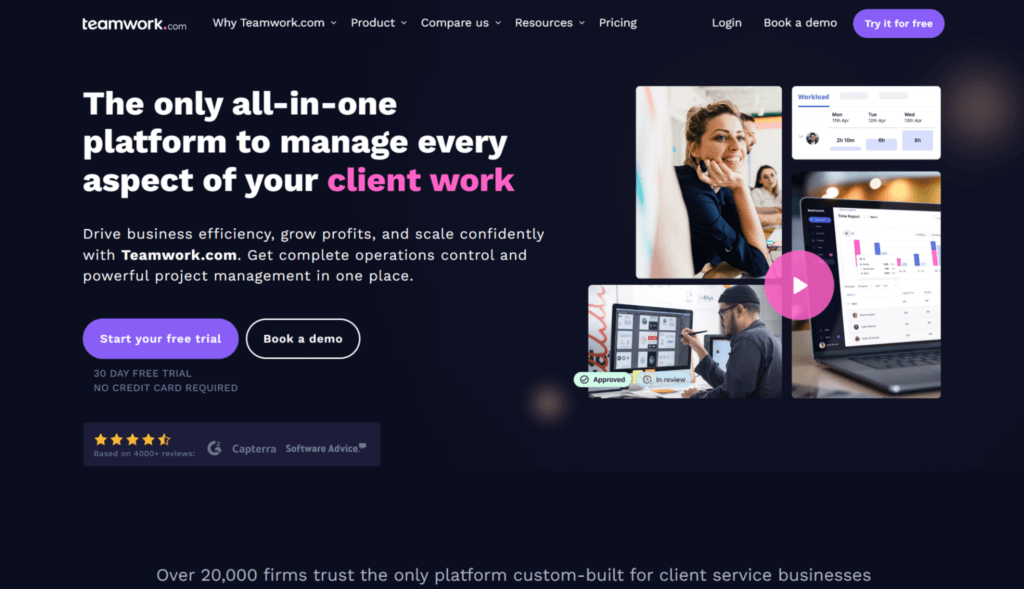
Teamwork is the only platform designed to simplify client operations and deliver projects efficiently with ready-to-use templates for timely and budget-friendly completion.
Teamwork simplifies tasks like managing client assets, project timelines, time, rates, and finances and balancing capacity across projects. It helps to organize operations in a single system.
With teamwork, teams can excel in performance and deliver exceptional results through process automation and integration of tools.
Features:
- Allows users to effortlessly add tasks from email to teamwork.
- Real-time updates and notifications
- Monitors expenses such as time, rates, and money while balancing budgetary fluctuations.
- Users can create and manage detailed task lists using the Gantt Chart view.
- Built-in timer functionality for tasks, task estimates, and due dates for efficient deadline management.
- Simplify operations with pre-built templates.
Pros:
- Easy-to-use interface and navigation
- Excellent customer service
- Mobile app support
- Super detailed and organized
- enables real-time task progress and team development monitoring, providing a clearer view of daily projects.
Cons:
- The Teamwork chat is unusable and requires improvement
- The mobile app UI is not good
- Lacks proper time tracking feature
Pricing:
- 30-day free trial available
- Starter: $5.99 per person/ per month ( 3 users minimum)
- Delivery: $9.99 per person/ per month ( 1 users minimum)
- Grow: $19.99 per person/ per month ( 5 users minimum)
6. Monday.com
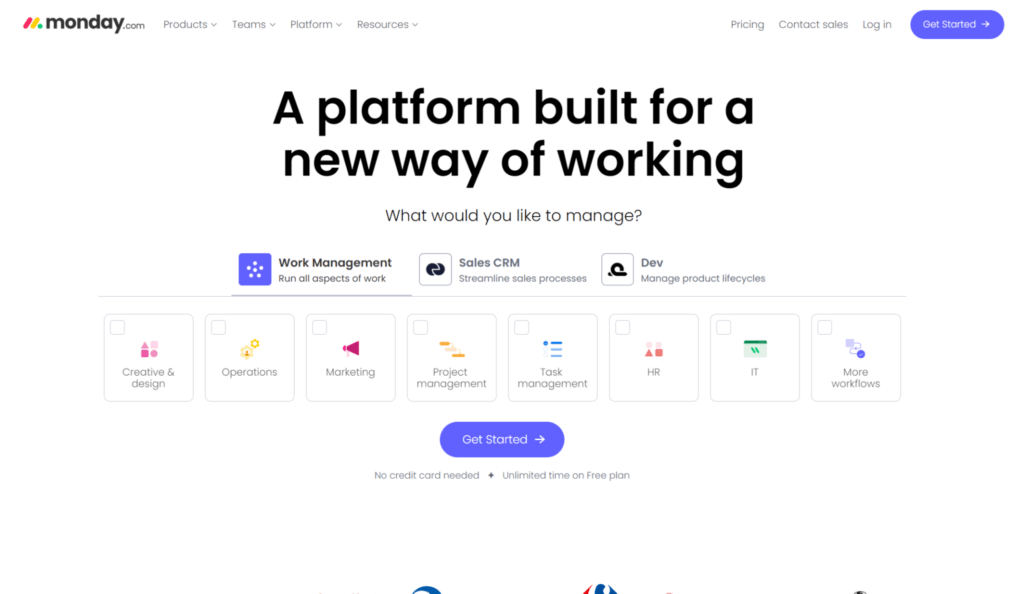
Monday.com is an all-in-one resource management platform that simplifies workload planning, prioritizes schedules, and tracks resources across multiple projects.
It offers a user-friendly interface with customizable features, allowing project managers to efficiently allocate tasks and track resources. Monday.com also offers custom time tracking and real-time updates on task completion and sends emails when the due date approaches.
It also offers reporting features and customizable templates, ensuring effective teamwork and clarity through Gantt charts and visual aids.
Features:
- Offers a user-friendly workspace with dashboards and provides notifications about team members’ tasks or project updates.
- Offers industry-specific solutions like Monday Work Management, Monday Sales CRM, and Monday Dev
- Variety of customizable templates and workflows
- Extensive integration with other apps and websites
- Automation can simplify processes, making tasks easier and more efficient for all team members.
Pros:
- Easy to use drag and drop tools
- Excellent customer support
- The platform offers easy navigation and allows for color customization
Cons:
- Certain features are missing in the mobile app version
- The “My work” board is less user-friendly
Pricing:
- Free version available (up to 2 seats)
- Basic: $9 (4 seats per month)
- Standard: $12 (3 seats per month)
- Pro: $19 (3 seats per month)
7. Notion

Notion is a resource management platform that connects documents, projects, and knowledge and allows teams to create, collaborate, and innovate in a connected workspace.
It allows users to visualize, filter, and sort non-typical resources, such as documents, tasks, and urgent items, according to their preferences. Notion also offers unique customization capabilities where users can track information, creating labels and tags.
Its user-friendly interface allows easy drag and drop of elements, and its integration of artificial intelligence enhances user capabilities across all notes and documents.
Features:
- allows for the creation of databases, notes, to-do lists, calendars, and more
- Through its built-in wikis, teams can search for anything
- Notion’s collaborative features allow sharing of pages and work with colleagues or friends.
- AI-powered content suggestions.
Pros:
- Easy to set and user-friendly interface
- Hundreds of pre-built templates
- available on various platforms, including web, desktop, and mobile applications.
Cons:
- Lack of specific functions ( like hide page feature, visual functionality, and more)
- New users may find the platform’s extensive features overwhelming and need time to fully utilize its potential.
Pricing:
- Free version available
- Plus: $16 per user per month
- Business: $23 per user per month
8. Runn
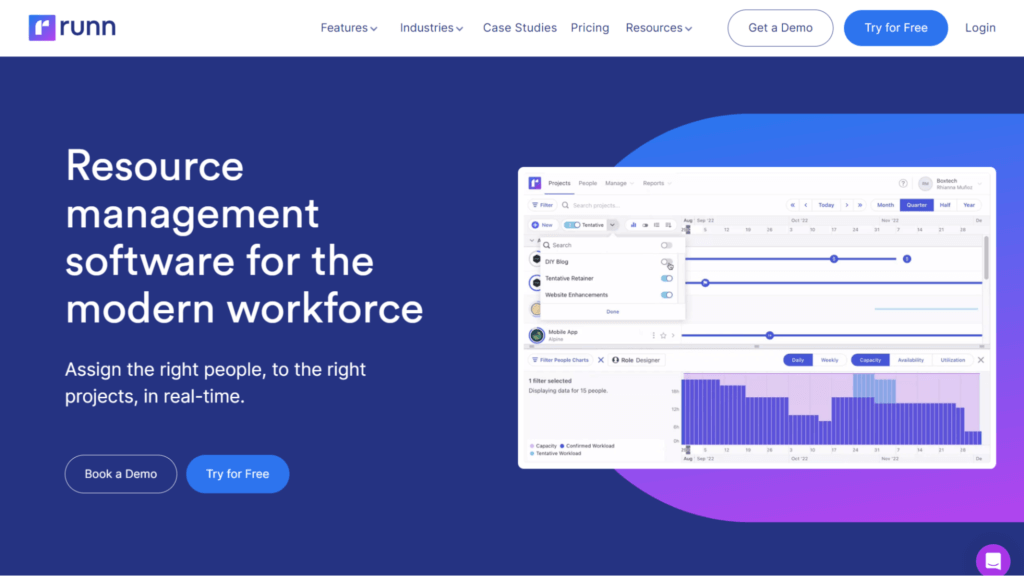
Runn is a modern resource management software best known for managing and tracking resources in real-time. The tool offers real-time resource, demand, capacity planning, integrated time tracking, and robust forecasting capabilities.
Its sleek design and interactive interface allow you to easily track staff availability and assess your team capacity and workload.
Runn’s project planning feature ensures on-time completion and optimal project selection, while its forecasting feature allows for precise anticipation of capacity, projects, scenarios, and financials.
Features:
- Easily schedule resources by dragging and dropping them.
- Monitor the difference between the time spent on a task and the allocated time, monitor projects, analyze forecasts, and track utilization and overall financial performance.
- API and Integrations
Pros:
- Track financial metrics
- Easy to use and navigate
- Excellent customer support service
- Built-in reporting and forecasting
Cons:
- Lacks advance features
- Limited integration allowed
- Difficulty in managing public holidays
Pricing:
- Startup: Free ( 5 people managed per month)
- Pro: $10 ( 1 person managed per month)
9. Smartsheet
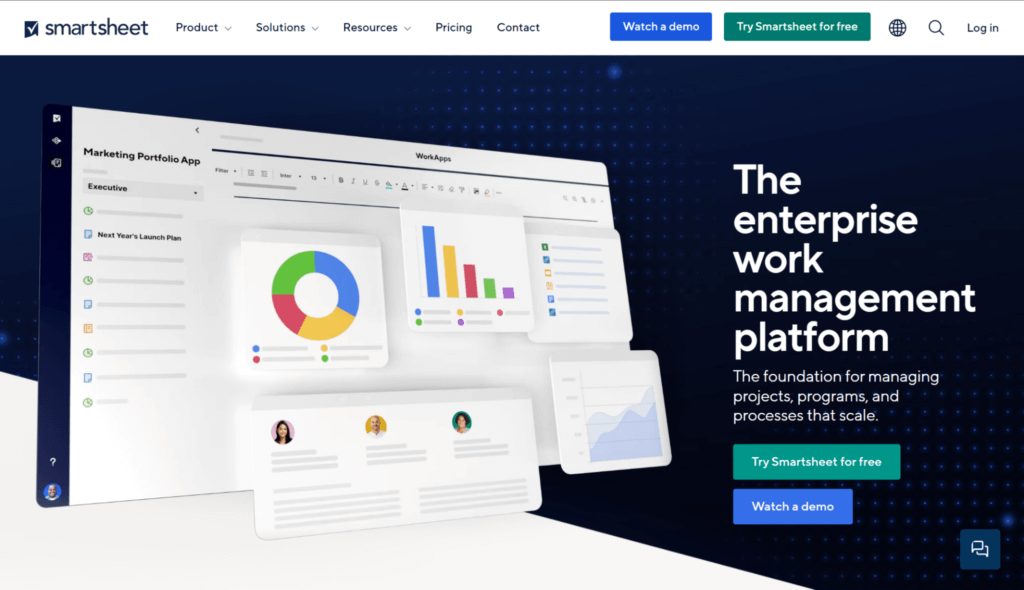
Smartsheet is another powerful resource management platform that offers a variety of features, including views, workflows, reports, and dashboards to suit various projects. It allows teams to manage reports and automate processes.
It helps schedule suitable candidates for projects, manage project time, and predict hiring needs in real-time. Smartsheet integrates with other software, automates tasks with no codes, saves time, and eliminates repetitive tasks.
Smartsheet allows you to view available assignments and current work and vacation statuses and assign work based on matching roles, skills, and availability.
Features:
- Gantt charts with additional features is a powerful tool that improves project management tools
- Built-in templates
- Automates project updates and notifications, ensuring resource planning managers are informed about project changes
- Sets email automation for task assignment
Pros:
- User-friendly interface
- Give reminders to save data
- Effortless time-tracking
Cons:
- Lacks extensive formatting and modification options
- Limited sheet options available
Pricing:
- Free plan available
- Pro: $7 ( 1 user per month)
- Business: $25 (3 users per month)
10. Asana

Asana is a powerful resource management tool for collaboration and efficient task management. It offers clarity and allows teams to move faster and accomplish more with less, regardless of geographical location.
Asana helps create custom workflows and automation, driving productivity. With Asana, you can visualize the state of your team’s work with real-time charts and insights. It eliminates missed deadlines, allowing teams to achieve greater results.
Features:
- Assign specific tasks to individual users, outlining their responsibilities and deadlines.
- Users can quickly move tasks and adjust dependencies by using the drag-and-drop functionality.
- With a calendar view feature, projects are planned and executed according to a schedule, detailing their due dates and daily deliverables.
- Monitor resource allocation to identify shortages.
- Users can add labels to tasks to enable sorting, filtering, and automatic reporting of work.
- Project updates can be completed quickly and efficiently using time-saving automation.
Pros:
- Versatile and customizable
- User-friendly interface
- Simple to collaborate and set deadlines
Cons:
- Lack of built-in time tracking
- The steep learning curve is complex for new users
Pricing:
- Personal: FREE ( collaborate up to 10 teammates)
- Starter: US$ 10.99 per user per month ( Collaborate with up to 500 teammates)
- Advance: US$ 24.99 per user per month ( Collaborate with up to 500 teammates)
We’ve listed all the resource management software with the help of various online communities and forums like G2.com, Capterra.com to compare their features and benefits along with pricing. These tools will help you manage your resources effectively, whether it’s for team management, client deliverables, or work management.
Each tool has its strengths and weaknesses. We’d love to hear about your experiences, so please don’t hesitate to get in touch with us!
Explore More My Best Tools List
1. Best Chatbot Builder Tools For Your Business In 2025
2. 10 Best Free Software To Create Invoice And Billing of 2025
3. 9 Best SEO Monitoring Tools In 2025 To Boost Your Rankings
4. Top 20+ SaaS Deals For Black Friday And Cyber Monday
5. Top 10 Black Friday Deals On SEO Tools 2024
6. Best WordPress Black Friday & Cyber Monday Deals 2024


